Deck 4: Introduction to Gases
Question
Question
Question
Question
Question
Question
Question
Question
Question
Question
Question
Question
Question
Question
Question
Question
Question
Question
Question
Question
Question
Question
Question
Question
Question
Question
Question
Question
Question
Question
Question
Question
Question
Question
Question
Question
Question
Question
Question
Question
Question
Question
Question
Question
Question
Question
Question
Question
Question
Question
Question
Question
Question
Question
Question
Question
Question
Question

Unlock Deck
Sign up to unlock the cards in this deck!
Unlock Deck
Unlock Deck
1/58
Play
Full screen (f)
Deck 4: Introduction to Gases
1
Which of the following is the best approximation of the relative densities of air and water,when both are at room temperature?
A)The density of air is about 800 times greater than the density of water.
B)The density of water is about 800 times greater than the density of air.
C)The density of air is about 80,000 times greater than the density of water.
D)The density of water is about 80,000 times greater than the density of air.
E)The density of air is about 800,000 times greater than the density of water.
A)The density of air is about 800 times greater than the density of water.
B)The density of water is about 800 times greater than the density of air.
C)The density of air is about 80,000 times greater than the density of water.
D)The density of water is about 80,000 times greater than the density of air.
E)The density of air is about 800,000 times greater than the density of water.
The density of water is about 800 times greater than the density of air.
2
Consider the open-end manometer shown below. 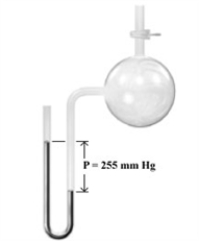 When the pressure of the atmosphere is 754 mmHg,what is the pressure of the gas sample?
When the pressure of the atmosphere is 754 mmHg,what is the pressure of the gas sample?
A)225 mm Hg
B)754 mm Hg
C)499 mm Hg
D)1009 mm Hg
 When the pressure of the atmosphere is 754 mmHg,what is the pressure of the gas sample?
When the pressure of the atmosphere is 754 mmHg,what is the pressure of the gas sample?A)225 mm Hg
B)754 mm Hg
C)499 mm Hg
D)1009 mm Hg
1009 mm Hg
3
Which of the following is correct?
A)5.99 × 108 in. Hg = 1.77 × 105 Pa
B)25.0 psi = 172 kPa
C)5.64 × 105 atm = 742 mm Hg
D)75.0 cm Hg = 75.0 torr
E)153 kPa = 1.55 × 104 atm
A)5.99 × 108 in. Hg = 1.77 × 105 Pa
B)25.0 psi = 172 kPa
C)5.64 × 105 atm = 742 mm Hg
D)75.0 cm Hg = 75.0 torr
E)153 kPa = 1.55 × 104 atm
25.0 psi = 172 kPa
4
Which of the following statements is true?
A)The actual volume of ideal gas molecules is negligible compared to the space they occupy
B)In an ideal gas, the volume of the molecules is typically as low as 10% of the total container volume
C)The distances between ideal gas molecules are usually about the same as the diameter of the molecules
D)Given that there is no chemical reaction between two gases, the ability to mix the gases in a rigid container of fixed volume depends on the external atmospheric pressure
E)Ideal gas molecules usually touch one another in a small container with low pressure and high temperature
A)The actual volume of ideal gas molecules is negligible compared to the space they occupy
B)In an ideal gas, the volume of the molecules is typically as low as 10% of the total container volume
C)The distances between ideal gas molecules are usually about the same as the diameter of the molecules
D)Given that there is no chemical reaction between two gases, the ability to mix the gases in a rigid container of fixed volume depends on the external atmospheric pressure
E)Ideal gas molecules usually touch one another in a small container with low pressure and high temperature

Unlock Deck
Unlock for access to all 58 flashcards in this deck.
Unlock Deck
k this deck
5
A perfume bottle is opened in a dressing room,and a short while later you detect the odor in the living room.Which of the following features of the ideal gas model best explains this phenomenon?
A)Gases consist of molecular particles moving at any instant in straight lines
B)Molecules collide with each other and with the container walls without loss of energy
C)Gas molecules behave as independent particles
D)Gas molecules are very widely spaced
E)The actual volume of molecules is negligible compared to the space they occupy
A)Gases consist of molecular particles moving at any instant in straight lines
B)Molecules collide with each other and with the container walls without loss of energy
C)Gas molecules behave as independent particles
D)Gas molecules are very widely spaced
E)The actual volume of molecules is negligible compared to the space they occupy

Unlock Deck
Unlock for access to all 58 flashcards in this deck.
Unlock Deck
k this deck
6
Which of the following statements is false?
A)Particle motion explains why gases fill their containers
B)When an individual particle in a gaseous sample strikes a container wall, it exerts a force at the point of collision
C)Gases consist of molecular particles moving at any given instant in straight lines
D)Gas pressures depend on the depth to which a container is filled with a gas
E)Gas pressures are independent of external factors such as gravitational forces
A)Particle motion explains why gases fill their containers
B)When an individual particle in a gaseous sample strikes a container wall, it exerts a force at the point of collision
C)Gases consist of molecular particles moving at any given instant in straight lines
D)Gas pressures depend on the depth to which a container is filled with a gas
E)Gas pressures are independent of external factors such as gravitational forces

Unlock Deck
Unlock for access to all 58 flashcards in this deck.
Unlock Deck
k this deck
7
Which of the following statements are true?
i.One standard atmosphere of pressure is defined as 760 mm Hg.
ii.To two significant figures,one atmosphere and one bar are equal.
iii.Gauge pressure is the pressure above atmospheric pressure.
A)i only
B)i and ii
C)i and iii
D)ii and iii
E)i, ii, and iii
i.One standard atmosphere of pressure is defined as 760 mm Hg.
ii.To two significant figures,one atmosphere and one bar are equal.
iii.Gauge pressure is the pressure above atmospheric pressure.
A)i only
B)i and ii
C)i and iii
D)ii and iii
E)i, ii, and iii

Unlock Deck
Unlock for access to all 58 flashcards in this deck.
Unlock Deck
k this deck
8
Convert 13.3 psi to kPa and torr.
A)1.35 × 103 kPa; 1.01 × 104 torr
B)91.7 kPa; 688 torr
C)1.93 kPa; 0.257 torr
D)91.7 kPa; 0.257 torr
E)1.93 kPa; 688 torr
A)1.35 × 103 kPa; 1.01 × 104 torr
B)91.7 kPa; 688 torr
C)1.93 kPa; 0.257 torr
D)91.7 kPa; 0.257 torr
E)1.93 kPa; 688 torr

Unlock Deck
Unlock for access to all 58 flashcards in this deck.
Unlock Deck
k this deck
9
Which of the following pressures is equal to 0.80 atm?
A)9.5 × 102 torr
B)1.3 bar
C)24 in. Hg
D)18 psi
E)1.0 kPa
A)9.5 × 102 torr
B)1.3 bar
C)24 in. Hg
D)18 psi
E)1.0 kPa

Unlock Deck
Unlock for access to all 58 flashcards in this deck.
Unlock Deck
k this deck
10
Examine the barometer shown below. 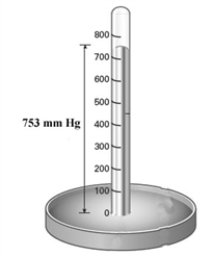 Convert the pressure reading on the barometer to atm and psi.
Convert the pressure reading on the barometer to atm and psi.
A)0.991 atm; 14.6 psi
B)0.991 atm; 3.90 × 102 psi
C)5.72 × 103 atm; 14.6 psi
D)5.72 × 103 atm; 3.90 × 102 psi
E)75.3 atm; 1.11 × 103 psi
 Convert the pressure reading on the barometer to atm and psi.
Convert the pressure reading on the barometer to atm and psi.A)0.991 atm; 14.6 psi
B)0.991 atm; 3.90 × 102 psi
C)5.72 × 103 atm; 14.6 psi
D)5.72 × 103 atm; 3.90 × 102 psi
E)75.3 atm; 1.11 × 103 psi

Unlock Deck
Unlock for access to all 58 flashcards in this deck.
Unlock Deck
k this deck
11
A bubble of steam rises to the top of a container of boiling water.Which of the following features of the ideal gas model best explains this phenomenon?
A)Gases consist of molecular particles moving at any instant in straight lines
B)Molecules collide with each other and with the container walls without loss of energy
C)Gas molecules behave as independent particles
D)Gas molecules are very widely spaced
E)The actual volume of molecules is negligible compared to the space they occupy
A)Gases consist of molecular particles moving at any instant in straight lines
B)Molecules collide with each other and with the container walls without loss of energy
C)Gas molecules behave as independent particles
D)Gas molecules are very widely spaced
E)The actual volume of molecules is negligible compared to the space they occupy

Unlock Deck
Unlock for access to all 58 flashcards in this deck.
Unlock Deck
k this deck
12
Which of the following statements is true?
A)The attractive forces among ideal gas molecules are known as kinetic molecular forces
B)Ideal gas molecules behave as independent particles
C)The movement of a given ideal gas molecule is influenced only by the molecules in the immediate vicinity of that molecule
D)The attractive forces among ideal gas molecules are short-range forces
E)The attractive forces among ideal gas molecules primarily depend upon the size of the particles
A)The attractive forces among ideal gas molecules are known as kinetic molecular forces
B)Ideal gas molecules behave as independent particles
C)The movement of a given ideal gas molecule is influenced only by the molecules in the immediate vicinity of that molecule
D)The attractive forces among ideal gas molecules are short-range forces
E)The attractive forces among ideal gas molecules primarily depend upon the size of the particles

Unlock Deck
Unlock for access to all 58 flashcards in this deck.
Unlock Deck
k this deck
13
Which of the following statements is false?
A)Gas molecules collide with each other without loss of energy
B)Gas molecules collide with the container walls without loss of energy
C)The pressure of a gas at constant temperature in a sealed container will gradually decrease
D)Because of the relationship between temperature and average molecular speed, the temperature of a gas would drop if energy were lost in collisions
E)Friction does not slow down gas particles and cause them to stop moving
A)Gas molecules collide with each other without loss of energy
B)Gas molecules collide with the container walls without loss of energy
C)The pressure of a gas at constant temperature in a sealed container will gradually decrease
D)Because of the relationship between temperature and average molecular speed, the temperature of a gas would drop if energy were lost in collisions
E)Friction does not slow down gas particles and cause them to stop moving

Unlock Deck
Unlock for access to all 58 flashcards in this deck.
Unlock Deck
k this deck
14
Consider the mercury barometer shown below. 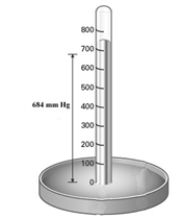 What is the equivalent of pressure reading in torr?
What is the equivalent of pressure reading in torr?
A)684 torr
B)0.900 torr
C)6.75 torr
D)46.6 torr
E)1444 torr
 What is the equivalent of pressure reading in torr?
What is the equivalent of pressure reading in torr?A)684 torr
B)0.900 torr
C)6.75 torr
D)46.6 torr
E)1444 torr

Unlock Deck
Unlock for access to all 58 flashcards in this deck.
Unlock Deck
k this deck
15
On a day when atmospheric pressure is 14.6 psi,a tire pressure gauge is used to measure the pressure of an automobile tire and it registers 42.0 psi.What is the actual air pressure inside the tire?
A)14.6 psi
B)42.0 psi
C)56.6 psi
D)27.4 psi
E)84.0 psi
A)14.6 psi
B)42.0 psi
C)56.6 psi
D)27.4 psi
E)84.0 psi

Unlock Deck
Unlock for access to all 58 flashcards in this deck.
Unlock Deck
k this deck
16
Consider the following weather map showing the southwestern part of the United States. 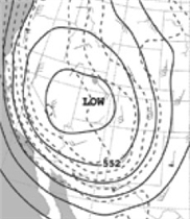 This map seems to indicate that this geographical region:
This map seems to indicate that this geographical region:
A)is experiencing barometric pressures greater than 760 mm Hg.
B)that air masses are descending and warming.
C)cloud formation is likely.
D)is experiencing lower than normal temperatures.
E)All of the above are likely to occur in this region in the time frame of this map.
 This map seems to indicate that this geographical region:
This map seems to indicate that this geographical region:A)is experiencing barometric pressures greater than 760 mm Hg.
B)that air masses are descending and warming.
C)cloud formation is likely.
D)is experiencing lower than normal temperatures.
E)All of the above are likely to occur in this region in the time frame of this map.

Unlock Deck
Unlock for access to all 58 flashcards in this deck.
Unlock Deck
k this deck
17
Convert 1.47 atm to psi and in.Hg.
A)0.100 psi; 0.0491 in. Hg
B)1.12 × 103 psi; 149 in. Hg
C)149 psi; 1.12 × 103 in. Hg
D)1.49 × 105 psi; 1.12 × 103 in. Hg
E)21.6 psi; 44.0 in. Hg
A)0.100 psi; 0.0491 in. Hg
B)1.12 × 103 psi; 149 in. Hg
C)149 psi; 1.12 × 103 in. Hg
D)1.49 × 105 psi; 1.12 × 103 in. Hg
E)21.6 psi; 44.0 in. Hg

Unlock Deck
Unlock for access to all 58 flashcards in this deck.
Unlock Deck
k this deck
18
Which of the following is incorrect?
A)1.35 atm = 1.03 × 103 mm Hg
B)1.12 × 105 Pa = 33.1 in. Hg
C)536 torr = 53.6 cm Hg
D)95.5 kPa = 9.67 × 103 atm
E)747 mm Hg = 9.96 × 104 Pa
A)1.35 atm = 1.03 × 103 mm Hg
B)1.12 × 105 Pa = 33.1 in. Hg
C)536 torr = 53.6 cm Hg
D)95.5 kPa = 9.67 × 103 atm
E)747 mm Hg = 9.96 × 104 Pa

Unlock Deck
Unlock for access to all 58 flashcards in this deck.
Unlock Deck
k this deck
19
Which of the following statements is true?
A)Gas particles often are attracted to one another and therefore behave as grouped particles.
B)The volume occupied by particles of a gas typically accounts for about 10-25% of the container volume.
C)Particles in a gas have very little space between them.
D)Gas particles gradually decrease in total kinetic energy over time.
E)Gases consist of molecular (or atomic) particles moving at any given instant in straight lines.
A)Gas particles often are attracted to one another and therefore behave as grouped particles.
B)The volume occupied by particles of a gas typically accounts for about 10-25% of the container volume.
C)Particles in a gas have very little space between them.
D)Gas particles gradually decrease in total kinetic energy over time.
E)Gases consist of molecular (or atomic) particles moving at any given instant in straight lines.

Unlock Deck
Unlock for access to all 58 flashcards in this deck.
Unlock Deck
k this deck
20
Consider the following image showing a sample of a trapped gas in a cylinder with a movable piston. 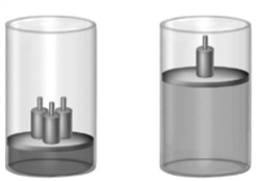 Which of the following statements is(are)illustrated by this image?
Which of the following statements is(are)illustrated by this image?
i.Gases may be compressed.
ii.Gases expand to fill their containers uniformly.
iii.All gases have low density.
iv.Gases may be mixed.
V.A confined gas exerts constant pressure on the walls of its container uniformly in all directions.
A)i only
B)ii only
C)iii only
D)ii and iv
E)i and ii
 Which of the following statements is(are)illustrated by this image?
Which of the following statements is(are)illustrated by this image?i.Gases may be compressed.
ii.Gases expand to fill their containers uniformly.
iii.All gases have low density.
iv.Gases may be mixed.
V.A confined gas exerts constant pressure on the walls of its container uniformly in all directions.
A)i only
B)ii only
C)iii only
D)ii and iv
E)i and ii

Unlock Deck
Unlock for access to all 58 flashcards in this deck.
Unlock Deck
k this deck
21
Which of the following correctly describes the relationship between the volume and temperature of a fixed quantity of an ideal gas at constant pressure?
i.V ∝ T
ii.V ∝ 1/T
iii.V = kT
iv.V = k(1/T)
A)iv only
B)i and ii
C)iii and iv
D)i and iii
E)ii and iv
i.V ∝ T
ii.V ∝ 1/T
iii.V = kT
iv.V = k(1/T)
A)iv only
B)i and ii
C)iii and iv
D)i and iii
E)ii and iv

Unlock Deck
Unlock for access to all 58 flashcards in this deck.
Unlock Deck
k this deck
22
Which of the following correctly expresses Charles's Law?
A)V ∝ 1/P
B)V ∝ n
C)V ∝ 1/n
D)V ∝ T
E)V ∝ 1/T
A)V ∝ 1/P
B)V ∝ n
C)V ∝ 1/n
D)V ∝ T
E)V ∝ 1/T

Unlock Deck
Unlock for access to all 58 flashcards in this deck.
Unlock Deck
k this deck
23
Consider the following graph.The data for the graph was obtained at constant temperature. 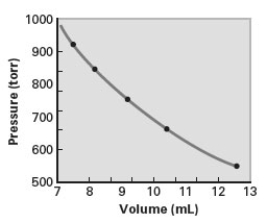 Which of the following correctly describes the relationship shown on the graph?
Which of the following correctly describes the relationship shown on the graph?
i.V ∝ P
ii.V ∝ 1/P
iii.V = kP
iv.V = k(1/P)
A)iv only
B)i and ii
C)iii and iv
D)i and iii
E)ii and iv
 Which of the following correctly describes the relationship shown on the graph?
Which of the following correctly describes the relationship shown on the graph?i.V ∝ P
ii.V ∝ 1/P
iii.V = kP
iv.V = k(1/P)
A)iv only
B)i and ii
C)iii and iv
D)i and iii
E)ii and iv

Unlock Deck
Unlock for access to all 58 flashcards in this deck.
Unlock Deck
k this deck
24
27.7 L of a gas is cooled at constant pressure from 87 °C to 24 °C.What will the volume be at the lower temperature?
A)0.0438 L
B)7.64 L
C)22.9 L
D)33.6 L
E)1.00 × 102 L
A)0.0438 L
B)7.64 L
C)22.9 L
D)33.6 L
E)1.00 × 102 L

Unlock Deck
Unlock for access to all 58 flashcards in this deck.
Unlock Deck
k this deck
25
The temperature of a gas is 23°C.What is its temperature in kelvins?
A)-250 K (-2.50 × 102) K
B)296 K
C)73 K
D)45 K
E)23 K
A)-250 K (-2.50 × 102) K
B)296 K
C)73 K
D)45 K
E)23 K

Unlock Deck
Unlock for access to all 58 flashcards in this deck.
Unlock Deck
k this deck
26
Which of the following correctly expresses Boyle's Law?
A)V ∝ 1/P
B)V ∝ P
C)V ∝ n
D)V ∝ 1/T
E)V ∝ T
A)V ∝ 1/P
B)V ∝ P
C)V ∝ n
D)V ∝ 1/T
E)V ∝ T

Unlock Deck
Unlock for access to all 58 flashcards in this deck.
Unlock Deck
k this deck
27
A fixed quantity of a gas is maintained at constant pressure as the volume decreases from 1.75 L to 1.25 L.If the temperature was 57 °C at the larger volume,what is it at the smaller volume?
A) –37 °C
B) 41 °C
C) 80. °C
D) 189 °C
E) 236 °C
A) –37 °C
B) 41 °C
C) 80. °C
D) 189 °C
E) 236 °C

Unlock Deck
Unlock for access to all 58 flashcards in this deck.
Unlock Deck
k this deck
28
A 0.732 m3 sample of a gas originally at 122.0°C must be reduced to a volume of 0.500 m3 at constant pressure.To what temperature must the sample be adjusted?
A) 578 °C
B) 270. °C
C) 179 °C
D) 83 °C
E) –3 °C
A) 578 °C
B) 270. °C
C) 179 °C
D) 83 °C
E) –3 °C

Unlock Deck
Unlock for access to all 58 flashcards in this deck.
Unlock Deck
k this deck
29
Consider the following graph. 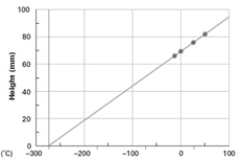 This graph is an illustration of which of the following laws?
This graph is an illustration of which of the following laws?
A)Charles's law
B)Boyle's law
C)combined gas law
D)law of conservation of mass
E)law of conservation of energy
 This graph is an illustration of which of the following laws?
This graph is an illustration of which of the following laws?A)Charles's law
B)Boyle's law
C)combined gas law
D)law of conservation of mass
E)law of conservation of energy

Unlock Deck
Unlock for access to all 58 flashcards in this deck.
Unlock Deck
k this deck
30
A container holds 34.3 m3 of gas at 65.0°C.If pressure remains constant,what will the volume be if the temperature falls to 25 °C?
A)38.9 m3
B)0.0331 m3
C)89.2 m3
D)30.2 m3
E)13.2 m3
A)38.9 m3
B)0.0331 m3
C)89.2 m3
D)30.2 m3
E)13.2 m3

Unlock Deck
Unlock for access to all 58 flashcards in this deck.
Unlock Deck
k this deck
30
AA

Unlock Deck
Unlock for access to all 58 flashcards in this deck.
Unlock Deck
k this deck
31
A gas has a volume of 3.77 m3 at 271 kPa.What will be its volume if the pressure is changed to 535 kPa?
A)0.134 m3
B)0.524 m3
C)1.91 m3
D)7.44 m3
E)5.47 × 105 m3
A)0.134 m3
B)0.524 m3
C)1.91 m3
D)7.44 m3
E)5.47 × 105 m3

Unlock Deck
Unlock for access to all 58 flashcards in this deck.
Unlock Deck
k this deck
32
A cylindrical gas chamber has a piston at one end that can be used to compress or expand the gas.If the gas is initially at 992 torr when the volume is 2.77 L,what will be the volume if the pressure is reduced to 501 torr at constant temperature?
A)0.182 L
B)0.715 L
C)1.40 L
D)5.48 L
E)1.38 × 106 L
A)0.182 L
B)0.715 L
C)1.40 L
D)5.48 L
E)1.38 × 106 L

Unlock Deck
Unlock for access to all 58 flashcards in this deck.
Unlock Deck
k this deck
32
AA

Unlock Deck
Unlock for access to all 58 flashcards in this deck.
Unlock Deck
k this deck
33
The pressure on 474 mL of a gas is changed from 726 mm Hg to 622 mm Hg.What is the volume at the new pressure?
A)2.14 × 108 mL
B)553 mL
C)406 mL
D)0.00246 mL
E)0.00181 mL
A)2.14 × 108 mL
B)553 mL
C)406 mL
D)0.00246 mL
E)0.00181 mL

Unlock Deck
Unlock for access to all 58 flashcards in this deck.
Unlock Deck
k this deck
34
A gas sample was originally in a 2.50 × 102 mL container at 25 °C.The gas was transferred to an evacuated 5.00 × 102 mL container,and the pressure was the same in both containers.What is the temperature of the gas in the larger container?
A)596 °C
B)323 °C
C)50 °C
D)13 °C
E)-124 °C
A)596 °C
B)323 °C
C)50 °C
D)13 °C
E)-124 °C

Unlock Deck
Unlock for access to all 58 flashcards in this deck.
Unlock Deck
k this deck
35
A gas with an initial volume of 34.4 mL,measured at -22°C,is heated to 0°C at constant pressure.What is the new volume of the gas?
A)31.6 mL
B)37.4 mL
C)0 mL
D)Heating a gas from a negative temperature to zero will cause it to explode because it then will be unstable
E)It is not possible for a gas to have a temperature of -22°C
A)31.6 mL
B)37.4 mL
C)0 mL
D)Heating a gas from a negative temperature to zero will cause it to explode because it then will be unstable
E)It is not possible for a gas to have a temperature of -22°C

Unlock Deck
Unlock for access to all 58 flashcards in this deck.
Unlock Deck
k this deck
36
A plastic glove when attached to a flask gives the system a flexible volume.See the illustration below. 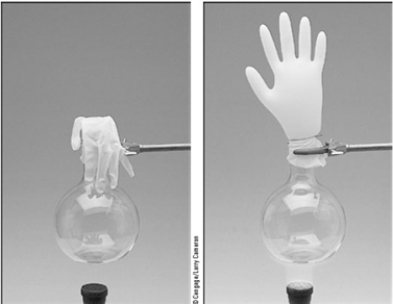 From a starting point of 257 mL at 22 °C,to what volume will the system change if the temperature rises to 137 °C due to the heating by the laboratory burner?
From a starting point of 257 mL at 22 °C,to what volume will the system change if the temperature rises to 137 °C due to the heating by the laboratory burner?
A)1.60 × 103 mL
B)41.3 mL
C)54.6 mL
D)357 mL
E)512 mL
 From a starting point of 257 mL at 22 °C,to what volume will the system change if the temperature rises to 137 °C due to the heating by the laboratory burner?
From a starting point of 257 mL at 22 °C,to what volume will the system change if the temperature rises to 137 °C due to the heating by the laboratory burner?A)1.60 × 103 mL
B)41.3 mL
C)54.6 mL
D)357 mL
E)512 mL

Unlock Deck
Unlock for access to all 58 flashcards in this deck.
Unlock Deck
k this deck
37
10.7 L of a gas at 1.75 atm are expanded to 20.0 L at a constant temperature.What is the new gas pressure?
A)0.0306 atm
B)0.936 atm
C)1.07 atm
D)3.27 atm
E)375 atm
A)0.0306 atm
B)0.936 atm
C)1.07 atm
D)3.27 atm
E)375 atm

Unlock Deck
Unlock for access to all 58 flashcards in this deck.
Unlock Deck
k this deck
38
A balloon is filled with a gas and has a volume of 1.79 L at 2.82 atm pressure.What will its volume be if the pressure is changed to 5.30 atm?
A)3.36 L
B)1.05 L
C)0.952 L
D)0.297 L
E)26.8 L
A)3.36 L
B)1.05 L
C)0.952 L
D)0.297 L
E)26.8 L

Unlock Deck
Unlock for access to all 58 flashcards in this deck.
Unlock Deck
k this deck
39
The volume of a sealed gas balloon is changed from 953 mL to 808 mL at constant temperature.The original pressure was 155 kPa.What is the pressure after the volume is reduced ?
A)0.00547 kPa
B)0.00761 kPa
C)131 kPa
D)183 kPa
E)1.19 × 108 kPa
A)0.00547 kPa
B)0.00761 kPa
C)131 kPa
D)183 kPa
E)1.19 × 108 kPa

Unlock Deck
Unlock for access to all 58 flashcards in this deck.
Unlock Deck
k this deck
40
0.847 L of a gas is heated from 12 °C to 33 °C at constant pressure.What will the volume be at the higher temperature?
A)1.10 L
B)0.909 L
C)0.789 L
D)0.308 L
E)2.33 L
A)1.10 L
B)0.909 L
C)0.789 L
D)0.308 L
E)2.33 L

Unlock Deck
Unlock for access to all 58 flashcards in this deck.
Unlock Deck
k this deck
41
A gas sample originally occupies 436 mL at 24 °C.When the volume is expanded to 612 mL and the temperature is increased to 97 °C,the pressure becomes 526 mm Hg.What was the original pressure?
A)183 mm Hg
B)301 mm Hg
C)467 mm Hg
D)593 mm Hg
E)920 mm Hg
A)183 mm Hg
B)301 mm Hg
C)467 mm Hg
D)593 mm Hg
E)920 mm Hg

Unlock Deck
Unlock for access to all 58 flashcards in this deck.
Unlock Deck
k this deck
42
The pressure of the gas in a compressed gas tank is 862 kPa when the gas is at 35 °C.To what will the pressure change when the temperature drops to 7 °C?
A)0.00128 kPa
B)4.31 × 103 kPa
C)172 kPa
D)784 kPa
E)948 kPa
A)0.00128 kPa
B)4.31 × 103 kPa
C)172 kPa
D)784 kPa
E)948 kPa

Unlock Deck
Unlock for access to all 58 flashcards in this deck.
Unlock Deck
k this deck
43
A canister holds a gas at 16.3 psi when the temperature is -15 °C.What will the pressure be when the temperature is increased to 20.°C?
A)-12.2 psi
B)-21.7 psi
C)21.7 psi
D)14.4 psi
E)18.5 psi
A)-12.2 psi
B)-21.7 psi
C)21.7 psi
D)14.4 psi
E)18.5 psi

Unlock Deck
Unlock for access to all 58 flashcards in this deck.
Unlock Deck
k this deck
44
The STP volume of an ideal gas is 2.06 m3.Calculate the volume of the sample at 1.75 atm and 27 °C.
A)0.773 m3
B)1.07 m3
C)1.29 m3
D)3.28 m3
E)3.96 m3
A)0.773 m3
B)1.07 m3
C)1.29 m3
D)3.28 m3
E)3.96 m3

Unlock Deck
Unlock for access to all 58 flashcards in this deck.
Unlock Deck
k this deck
45
A scientist builds a "pressure thermometer" by sealing air in a tank.If the pressure inside the tank is 946 mm Hg when it is placed in a boiling water bath at 99 °C,and 749 mm Hg when left on the laboratory bench,what is the temperature in the lab?
A)295 °C
B)197 °C
C)125 °C
D)78 °C
E)22 °C
A)295 °C
B)197 °C
C)125 °C
D)78 °C
E)22 °C

Unlock Deck
Unlock for access to all 58 flashcards in this deck.
Unlock Deck
k this deck
46
Calculate the original volume of a sealed balloon if it was originally at 25 °C and 1.02 atm,and then it was changed to 5.79 L,77 °C,and 1.72 atm.
A)4.03 L
B)3.17 L
C)8.31 L
D)2.92 L
E)11.5 L
A)4.03 L
B)3.17 L
C)8.31 L
D)2.92 L
E)11.5 L

Unlock Deck
Unlock for access to all 58 flashcards in this deck.
Unlock Deck
k this deck
47
A gas occupies 4.71 liters at 62 °C and 795 torr.What volume will it occupy if it is cooled to 17 °C and compressed to 911 torr?
A)3.56 L
B)6.23 L
C)1.13 L
D)4.75 L
E)4.67 L
A)3.56 L
B)6.23 L
C)1.13 L
D)4.75 L
E)4.67 L

Unlock Deck
Unlock for access to all 58 flashcards in this deck.
Unlock Deck
k this deck
48
A gas sample is originally at 93.9 kPa and 27 °C with a volume of 1.17 m3.What will be the resulting temperature if the pressure is adjusted to 117 kPa and the volume is reduced to 0.730 m3?
A)326 °C
B)113 °C
C)21 °C
D)-123 °C
E)-40 °C
A)326 °C
B)113 °C
C)21 °C
D)-123 °C
E)-40 °C

Unlock Deck
Unlock for access to all 58 flashcards in this deck.
Unlock Deck
k this deck
49
A gas storage tank holds a gas at 5.73 atm pressure at 22 °C.What will the pressure of the gas be when the temperature is lowered to 0 °C?
A)5.30 atm
B)6.19 atm
C)0.189 atm
D)0 atm
E)The temperature of a gas at 0 °C is undefined
A)5.30 atm
B)6.19 atm
C)0.189 atm
D)0 atm
E)The temperature of a gas at 0 °C is undefined

Unlock Deck
Unlock for access to all 58 flashcards in this deck.
Unlock Deck
k this deck
50
A fixed quantity of a gas is maintained at a constant temperature.The gas has a volume of 0.847 m3 at 735 torr.What is the pressure of the gas when the volume is changed to 0.905 m3?
A)0.00145 torr
B)0.00127 torr
C)781 torr
D)563 torr
E)688 torr
A)0.00145 torr
B)0.00127 torr
C)781 torr
D)563 torr
E)688 torr

Unlock Deck
Unlock for access to all 58 flashcards in this deck.
Unlock Deck
k this deck
51
The pressure of a gas is 817 torr at 55.0°C.The quantity of the gas is fixed and the volume remains constant as the pressure is adjusted to 6.00 × 102 torr.What is the resulting temperature of the gas?
A)-32 °C
B)40 °C
C)174 °C
D)241 °C
E)447 °C
A)-32 °C
B)40 °C
C)174 °C
D)241 °C
E)447 °C

Unlock Deck
Unlock for access to all 58 flashcards in this deck.
Unlock Deck
k this deck
52
20.0 L of a gas originally at 22 °C and 1.05 atm pressure are compressed to 10.0 L.The new temperature is 57 °C.What is the new pressure?
A)2.35 atm
B)5.44 atm
C)0.469 atm
D)1.88 atm
E)0.587 atm
A)2.35 atm
B)5.44 atm
C)0.469 atm
D)1.88 atm
E)0.587 atm

Unlock Deck
Unlock for access to all 58 flashcards in this deck.
Unlock Deck
k this deck
53
A gas sample occupies 8.15 volume units at 677 pressure units.If possible,find the volume of the gas if the pressure is changed to 278 pressure units.The pressure units are the same in both cases and the temperature is constant.
A)It is not possible to find the new volume, although it would be greater than the original volume.
B)It is not possible to find the new volume, although it would be less than the original volume.
C)It is not possible to find the new volume, and no comparison with the original volume is possible.
D)19.8 volume units
E)3.35 volume units
A)It is not possible to find the new volume, although it would be greater than the original volume.
B)It is not possible to find the new volume, although it would be less than the original volume.
C)It is not possible to find the new volume, and no comparison with the original volume is possible.
D)19.8 volume units
E)3.35 volume units

Unlock Deck
Unlock for access to all 58 flashcards in this deck.
Unlock Deck
k this deck
54
4.27 L of a gas are collected at 53 °C and 527 torr.What would this volume be if adjusted to STP?
A)0 L
B)7.35 L
C)5.16 L
D)3.54 L
E)2.48 L
A)0 L
B)7.35 L
C)5.16 L
D)3.54 L
E)2.48 L

Unlock Deck
Unlock for access to all 58 flashcards in this deck.
Unlock Deck
k this deck
55
A gas occupies a volume of 3.5 L at 24 °C and 883 mm Hg.What volume will it occupy at STP?
A)2.7 L
B)3.3 L
C)3.7 L
D)4.4 L
E)7.0 L
A)2.7 L
B)3.3 L
C)3.7 L
D)4.4 L
E)7.0 L

Unlock Deck
Unlock for access to all 58 flashcards in this deck.
Unlock Deck
k this deck
56
A gas is collected in a container of fixed volume at 25 °C.If the gas exerts a pressure of 685 mm Hg at this temperature,what will the temperature of the gas be when the pressure is 7.60 × 102 mm Hg?
A)331 °C
B)58 °C
C)28 °C
D)23 °C
E)-4 °C
A)331 °C
B)58 °C
C)28 °C
D)23 °C
E)-4 °C

Unlock Deck
Unlock for access to all 58 flashcards in this deck.
Unlock Deck
k this deck



